Hey, DC fans, time for a second trip in the Time Bubble. If you happened to have missed our first stop to March 1952, you can catch up here. This time, we pull out of the time stream at the second week of March, 1977 — 40 years ago!
In 1977, the second Wednesday in March fell on the 9th. Of course, there was no such thing as New Release Wednesday back before Diamond Distribution — heck, we’re stopping in at an era that was before most of the first comic books stores, even. Back in 1977, DC Comics hit newsstands (yes, newsstands!) twice per week, on Tuesday and Thursday. That means this week we’re taking a look at comics released on March 8, and March 10.
The big book this week was the latest creation by Smilin’ Steve Ditko, co-creator of Spider-Man and sole creator of Doctor Strange over at the House of Ideas, creator of The Question and the Ted Kord version of the Blue Beetle, who were still Charlton Comics properties at the time, and creator for DC of such familiar faces as Hawk & Dove, The Creeper, and co-creator of The Stalker. Okay . . . so maybe Stalker’s not a household name, but Shade, the Changing Man is still being published today, even if he’s now a girl!
Let’s de-bubble, and take a look around, shall we?
The first thing you’ll notice is that, starting this month, the standard 32-page DC comic sported a 35¢ price tag. DC had only been at the 30¢ price point for 15 months when this latest increase hit. For the record, 35¢ in 1977 is, at least according to the online inflation calculator maintained by the Bureau of Labor Statistics, about the same as $1.40 in 2017 dollars. So, still a comparative bargain. You see, although DC was then newly ensconced as a cog in the corporate empire that was TimeWarner, in 1977 it did not yet have 40,000 vice presidents and 12 layers of middle management to maintain. So, yeah, paper was cheaper, but so were its “labor” costs.
Anyway, on to the actual comics:
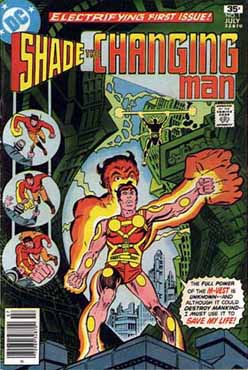 SHADE, THE CHANGING MAN #1
SHADE, THE CHANGING MAN #1
(on-sale March 8)
“Escape to Battleground Earth” is the intro and origin of Shade, created, as we’ve already noted, by Steve Ditko, with scripting chores over Ditko’s plot handled by Michael Fleisher.
Although I say “scripting,” Fleisher was actually credited with dialogue, as, according to editor Jack C. Harris, “someone at DC was not comfortable with Steve’s dialogue.” It makes sense that decision came from someone higher up in the chain of command than front-line editor Harris. After all, as he tells it in an interview with Jay Williams in Back Issue magazine #78 (cover-dated February 2015), he was assigned the Shade book after Ditko had already sold it to then Managing Editor Joe Orlando. How that came to be is probably an interesting story. Ditko had not had a series at DC since the late 1960s and was only given occasional short stories in anthology books, largely edited by Orlando. However, DC, flush with excitement from its new place in the TimeWarner empire, was in a rapid expansion mode, and several new series got a green light in 1976 and 1977, including Black Lightning, Secret Society of Super-Villains, Freedom Fighters, and Karate Kid, as well as revivals of old series including All-Star Comics, Teen Titans, Challengers of the Unknown, and the New Gods, among others. So, it’s not surprising that Orlando might have asked a recognized master of the comics form to pitch a new series.
It’s also not surprising that DC’s upper brass, whether Orlando or someone above his rung, might have held some trepidation regarding Ditko’s scripting skills. Although it’s trendy today to revile Stan Lee as someone who merely filled in the word balloons, while Jack Kirby and Steve Ditko created all the characters and plots, any kind of critical reading of Kirby & Ditko’s post-Lee work will reveal a marked decline in literary quality. Lee/Kirby and Lee/Ditko were creative teams greater than the sum of their parts. I’ve read that many at DC blamed the failure of Kirby’s Fourth World books on his scripting, and with some of Ditko’s self-published work already circulating, it’s not surprising they would have demanded a writing crutch. How Fleisher was chosen, however, is anybody’s guess.
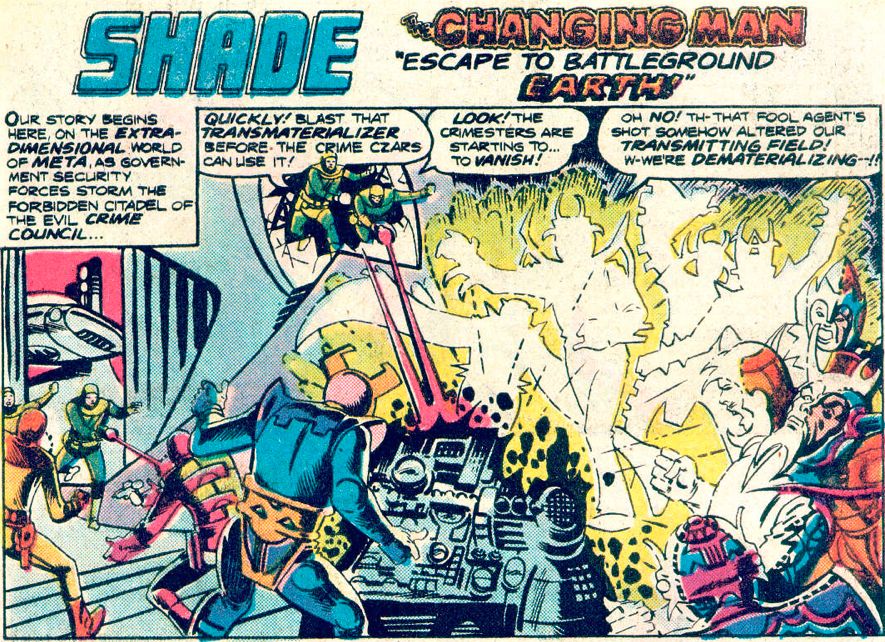
Harris was picked to edit, however, because he and Ditko were friendly. Although Ditko is widely regarded as one of the most churlish fellows one could ever hope to meet — and I acknowledge this being one of the few comic book lovers who’s actually a fan of his objectivist philosophy — he also was apparently not one to overlook a kindness. As Harris tells it in that Back Issue interview, Ditko had come into the office one day to deliver pages to Orlando and he invited him to wait in his office. From that a genuine friendship developed and Harris would often spend his lunch hour over at Ditko’s Manhattan studio, where they’d “talk about just about everything.” So, he was clearly the man for the job when it came to handling a book by the notoriously difficult Ditko.
Opinion of Ditko was so ingrained that, Harris said, he was told he should get “combat pay” for refereeing editorial meetings with Ditko and the comparatively ultra-progressive Fleisher. However, Harris said the meetings were always cordial, both men “such professionals,” that he “never sensed any tension between the two.”
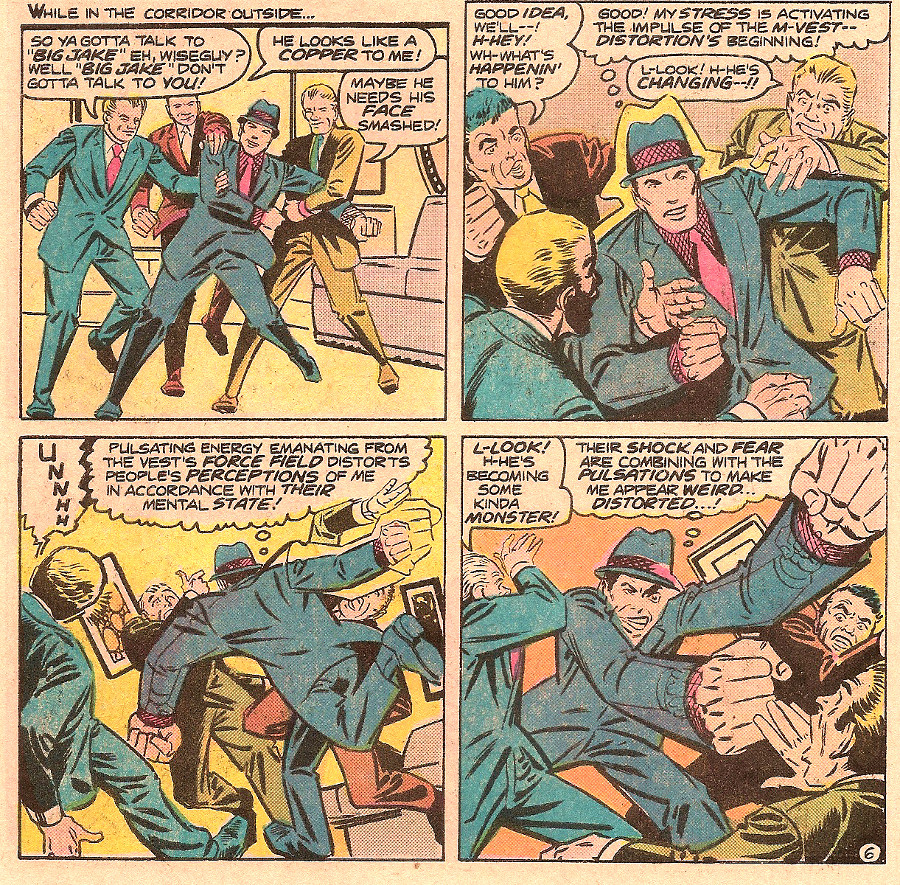 One person who was tense when it came to the Shade book, however, was letterer Bill Morse. In this fascinating review of the Shade logo, Todd Klein quotes Morse complaining that Ditko’s penciled pages would come to him with lettering penciled in, in a “very tiny hand” he recognized as Ditko’s craftsmanship.
One person who was tense when it came to the Shade book, however, was letterer Bill Morse. In this fascinating review of the Shade logo, Todd Klein quotes Morse complaining that Ditko’s penciled pages would come to him with lettering penciled in, in a “very tiny hand” he recognized as Ditko’s craftsmanship.
“His pencils for the lettering were pretty dark, and it was hard to erase after I had completed by lettering,” Morse said.
So, to my mind, that raises the question of how much of the scripting Fleisher was actually doing. The usual “Marvel-method” process used on Shade would be for pages to go from penciller, to scripter, to letterer, to inker. But it Morse was getting pages with Ditko lettering in balloons as well as caption boxes, were pages going back to Ditko after Fleisher wrote the dialogue, or was Morse getting raw Ditko, maybe working over it changes made by Fleisher.
Either way, Harris said in 2015 that Shade as a book suffered more from Fleisher’s contribution than Ditko’s. Asked what, in hindsight, he would have changed about the book to make it more successful, Harris said he should have “taken a heavier hand” with the dialogue.
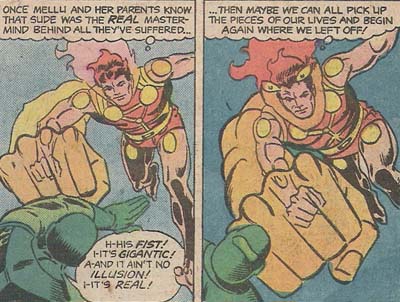 “[Fleisher] was very careful to make sure Steve’s story was being told, so the actual dialogue suffered,” he said. “All the characters sounded the same.”
“[Fleisher] was very careful to make sure Steve’s story was being told, so the actual dialogue suffered,” he said. “All the characters sounded the same.”
Of course, Harris also said he would have had Ditko pack a little less into each issue. The story of a lawman-turned-fugitive who escapes to Earth with a vest that causes others to see varying visions on him depending on their mental state, had “enough story in each book for three issues of any other comic at the time,” Harris said.
When TimeWarner executives ordered an across-the-board cut in the DC line a year after Shade’s launch, the story — perhaps apocryphal — is that all DC titles were ordered by sales, and a line was drawn. Anything above the line survived, anything below it got canceled. Kamandi, the Last Boy on Earth, Harris says, was the first title below the cut line. Others say Detective Comics also was below the line, but DC staffers educated their corporate parents on just where the “DC” in DC Comics came from, and the title survived by being repackaged as the better-selling Batman Family, which was canceled in its place.
Could anything have saved Shade? Harris doesn’t seem to think so. Sales of the book, he says, were “bad.”
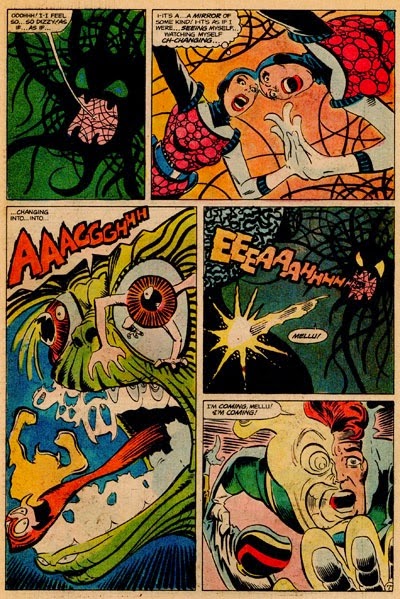 In the decades since, however, Shade has become a sort of “cult classic,” in Harris’ words.
In the decades since, however, Shade has become a sort of “cult classic,” in Harris’ words.
“I like to think we were ahead of our time and the audience back then just wasn’t ready for something as innovative as Shade, the Changing Man,” he said.
After Shade, Harris would continue to throw work Ditko’s way, even on the Legion of Super-Heroes, much to the chagrin of fans of that title, who thought Ditko’s style to staid and old-fashioned.
“Boy, did they hate those,” Harris said of Legion fans of the era. “They didn’t like those at all.”
Shade was, however, Ditko in his element, nearly at the top of his form, with the way-out renderings of Rac Shade’s power, and other-wordly dimensions on par with the best of his Doctor Strange work. Sadly, the multi-layered story, in which Shade, framed for the murder of his girlfriend’s parents, is pursued with a Kill Bill kind of death vengeance by his former lover, even as the mother turns out to be the Sude (or Supreme Decider) of his home dimension’s Crime Council, is, as Harris noted, packed to the panel borders with plot. It’s constant use of flashback makes it a challenging, but rewarding read.
After DC, Harris and Ditko would team on dozens of pitches made to piratically every small publisher in the business, although few ever say the warm side of a printing press.
“I’m willing to bet there is at least one Harris/Ditko proposal deep in the files of every independent publisher,” Harris said in this interview.

While little of that material is available, Ditko fans and the Ditko-curious alike can read the entire eight-issue Shade series, as well as the unpublished ninth issue, in The Steve Ditko Omnibus Starring Shade the Changing Man, a 464-page opus published in 2011 and now available on Amazon for as little as $19.29 used, or $39.70 new.
This series has been kind of hot lately, with #1 up to $20 in Near Mint. But you can expect to pay a mere $6 for a Fine condition copy, or $1.50 for Good.
Anyway, I think Shade is well worth your effort to track down. That said, let’s take a look at what else DC had to offer is this week in 1977.
 BATMAN #288
BATMAN #288
(on-sale March 8)
Penguin plagues Batman as head of “The Little Man Hall of Fame,” in the conclusion of a two-part story by David Vern Reed with art by Mike Grell & Bob Wiacek.
David Vern Reed wrote most issues from #267-304, including two of my all-time favorite Batman stories (probably only because of the impact they had on me as a kid), the “Where Were You on the Night Batman Was Killed?” multi-parter from #291-294 (which completely deserves to be collected in a modern TPB, and “The Last Batman Story” alt. future epic from #300.
Batman is now on his third ongoing series, at #18. However, if we count the 713 issues of Vol. 1 (1940-2011), along with #0 (1994) and #1,000,000 (1998) from that run, plus the 52 issues of Vol. 2 (2011-2016), along with its #0 (2012) and four 23-point issues (from 2013), and then the 18 issues of the current run, the next issue should be Batman #791.
As for #288, like most issues of the second V. Reed era, you can look to pay $25 for a Near Mint copy, at least according to online price guide ComicBookRealm.com. In Fine expect to pay $7.50, while a Good copy will set you back a mere $1.75, generally speaking.
 STARFIRE #6
STARFIRE #6
(on-sale March 8)
The anti-penultimate issue of Starfire’s short-lived series finds her at the “Citadel of Silence,” written by Steve Englehart, with pictures by Mike Vosburg and Vince Colletta.
It is sort of interesting to me that, here, right in the middle of runs on Detective Comics and Justice League of America that are much admired and highly sought after to this day, Englehart pumps out a couple of issues (this one and the next) of a title that is almost forgotten today, and which could not reappear under its original name. Because of that orange chick from the Titans, and all.
It’s been a l-o-o-o-o-n-g time since I read any of the books in this eight issue run, but as I recall she was never actually called Starfire in the book. The big whoop at the time was that the first issue had to CCA stamp. Here’s a quick primer for those of you too young to recall the once-ubiquitous Comics Code Authority. Starfire was the first DC heroine to get her own title since Supergirl in 1972, and there was some initial thought that maybe Starfire was too, um . . . breast-y for CCA approval, and market speculators snatched up the issue by the gross ton. As it turns out, the stamp simply fell off during printing, and, given that the story and art met the approval of the censors, the book hit the pits in value.
For years, this series languished in dollar bins, and even quarter bins. Today, you should not expect to pay more than $8 for a Near Mint copy of this particular issue (or any except #1, for that matter). A Fine copy will probably cost less than $2.50, while you’re paying too much if you shell out more than 50¢ for one in Good condition.
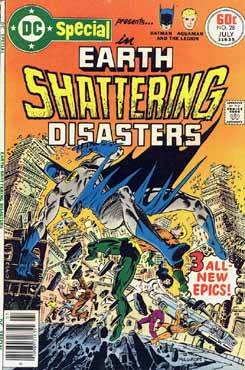 DC SPECIAL #28
DC SPECIAL #28
(on-sale March 10) [48 pages for 60¢]
And here’s a penultimate issue, featuring three all-new tales of natural disasters — although at 10, 12, and 11 pages, it’s hard to call them “EPICS!” as we see declared on the cover copy.
First up Batman’s in a quandary in “And the Town Came Tumbling Down,” written by the Answer Man himself, Bob Rozakis, and drawn by John Calnan and Tex Blaisdell. Then, Aquaman goes toe-to-fin with “A Creature of Death and Darkness,” with the help of writer Gerry Conway and the art team of Don Newton and Dan Adkins. Lastly, the Legion of Super-Heroes must solve the mystery of “The City That Stopped — Dead” a riddle concocted by Paul Levitz and depicted by Arvell Jones and Bob Layton.
DC Special began life on Aug. 6, 1968 as a bimonthly themed-reprint series, with stories chosen mostly by subject (Strange Sports in #s 7, 9, and 13), sometimes by character (Viking Prince in #12), and twice by creator (Carmine Infantino in #1, Joe Kubert in #4). The series was canceled with #15 (on-sale Sept. 2, 1971), but then revived with #16 (on Feb. 13, 1975). All but the final three issues were reprints packages. Even so, the squarebound packaging makes them hard to find in top grade and they command a decent price on the back issue market. When this series got the ax, it was immediately replaced on the schedule with the similarly-named DC Special Series.
Of the final three issues of this series that did feature original material, #27 (“Danger: Dinosaurs at Large!”) was in the 2012 Secret Society of Super-Villains collection, while #29 (“The Untold Origin of the Justice Society”) was included in the 2006 JSA collection. Of the three stories in this issue, the tale was included in the final edition (Vol. 13) of the Legion Archives series. However, the Batman and Aquaman stories have never been reprinted — in America, at least. Interestingly, when this issue was first promoted in DC’s “Daily Planet” promo page inside the comics, it pitched a Superman story alongside Aquaman and the Legion. Whatever became of that tale, I have no idea.
The second most expensive back issue on this week’s Time Bubble stop, this one will set you back around $32 in Near Mint. About $9.50 in Fine and $2.25 in Good should be about where you’ll land for full retail in those conditions.
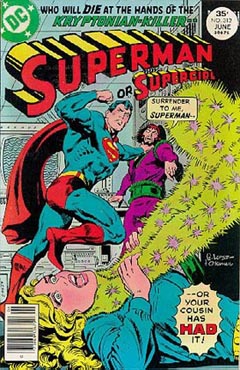 SUPERMAN #312
SUPERMAN #312
(on-sale March 10)
The Man of Steel gets a helping hand from the Maid of Might in a face-off against villains who vow, “Today the City . . . Tomorrow the World,” a story by Martin Pasko, drawn by Curt Swan and Frank Springer
Villain Amalak first appeared in Superman #190 (1966). After popping up again in #195 and #299, this four-parter in #311-314 was his swan song until rebooted by Kurt Busiek in his “Third Kryptonian” tale in #668-670 (2007-2008). The other villain, Nam-Ek, an immortal Kryptonian scientist, made his debut in Superman #282, and then in #s 311-315, dubbed by Amalak “The Antibiotic Man.” That was more or less it for him, apart from the 1982 mini-series The Phantom Zone. But Nam-Ek got a boost in notoriety space pirate Amalak never enjoyed, due to being featured in a pair of Season 5 episodes of the Smallville TV show. That character was the same in name only, however. Another version of Nam-Ek, or just Namek, appeared in the 2013 Man of Steel motion picture. Unnamed in the film, he is referred to in the Man of Steel: Friends and Foes “I Can Read!” children’s tie-in book to the film.
Generally, any Superman between #300-350 will cost you $10 in Near Mint. If you can stand a lesser condition, look to pay $3 for Fine and 75¢ for Good.
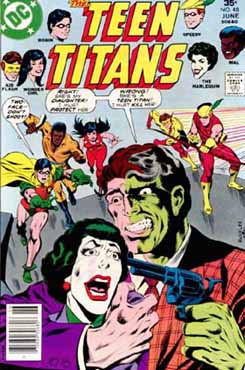 THE TEEN TITANS #48
THE TEEN TITANS #48
(on-sale March 10)
The Joker’s Daughter is actually Two-Face’s kid, which is why Harvey comes a-callin’ in “Daddy’s Little Crimefighter,” courtesy of Bob Rozakis on words and Jose Delbo and Vince Colletta on pictures.
The ’70s Titans revival was one of my favorite books of the era, and I was bitterly disappointed when it was canceled. Originally running from Nov. 18, 1965 to #43, on Nov. 9, 1972, the “junior Justice League” got its second chance to shine starting with #44, out on Aug. 19, 1976, lasting a mere 10 issues. It’s sometimes thought of today as yet another victim of the infamous DC Implosion, but it actually got the ax several months earlier, with th last issue (#53) on stands Nov. 22, 1977, a good nine months before the official collapse. So, I must have been one of the few young readers enjoying it.
Duela Dent made her debut in Batman Family #8 (on-sale Aug. 26, 1976) as Catgirl, becoming Joker’s Daughter. She also claimed to be the daughter of Penguin, the Scarecrow, and the Riddler, before finally outing Two-Face as her actual sperm daddy. She then joined the Titans in #46, claiming she wanted to atone for her fathers’ crimes. After defeating Two-Face, Duela’s changes identities, losing her Joker-like appearance but keeping the face paint as The Harlequin. See, if she’d just thought of “Harley Quinn,” she might still be a thing. After this title folded, Duela made a couple of appearances in Detective Comics as the Card Queen, then was pretty much forgotten and wiped out in 1985’s Crisis on Infinite Earths. She made a few rebooted appearance post-Crisis, before an entirely new, completely deranged version popped up in the New 52 era in Villains Month event aftermath to the “Death in the Family” storyline.
This issue also features the first appearance of Karen Beecher (who first appeared in #45) as Bumblebee. The character had a lot of potential, and still appears today, most recently as part of Keith Giffen’s 2009 Doom Patrol series and as part of the 2015 DC/Mattel Super Hero Girls action figure franchise. Still, her debut here is almost laughable, due primarily to the fact that her costume is a little to literal, with the “stinger” launched from where it would be on a real bumblebee — her butt!
With two debut appearances, this issue is our top dollar back issue of the week, netting $40 in Near Mint. Look to pay $12 for a Fine copy and $2.75 for Good.
And, just so we don’t give short shrift to the rest of the month, here’s a run-down for the rest of DC’s output for March 1977.
Tuesday, March 1
THE MIGHTY ISIS #5
Closing in on the end of the eight issue series, featuring “Perilous Pyramid Power,” by Jack C. Harris (writer), Mike Vosburg (penciller), and Vince Colletta (inker).
KAMANDI, THE LAST BOY ON EARTH #51
More apocalyptic action in, “The Next to the Last Boy on Earth,” by Steve Englehart (writer), Dick Ayers (penciller), and Alfredo Alcala (inker).
 SECRETS OF HAUNTED HOUSE #6
SECRETS OF HAUNTED HOUSE #6
Packs three stories into just 15 pages under a cover by the great Jim Aparo, with “Grave Situation” by Gerry Talaoc, “Deadly Allegiance,” by John Albano (writer) and Ruben Yandoc (artist), and “Valley of the Giants,” by Jack Oleck (writer) and Jess M. Jodloman (artist)
SGT. ROCK #305
Just four issues after finally take over the title that was Our Army at War, Rock and the combat-happy Joes of Easy Co. face “Dead Man’s Trigger” alongside Robert Kanigher (writer) and Joe Kuber (artist). Kanigher then treats us to a back-up tale, “The Bloody Banners,” with art by Bill Draut.
Thursday, March 3
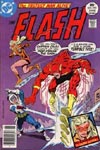 THE FLASH #250
THE FLASH #250
It’s the first appearance of Captain Cold’s kid sister, The Golden Glider, who hardly looks 40 years old today, in, “One Freeze-Dried Flash – Coming Right Up,” by Cary Bates (writer), Irv Novick (penciller), and Vince Colletta (inker).
JUSTICE LEAGUE OF AMERICA #143
While regular DC comics went up a nickel this month, JLA jumped a staggering dime, to 60¢, although in return we get 48 pages and, “A Tale of Two Satellites,” as in the JLA orbiting HQ, by Steve Englehart (writer), Dick Dillin (penciller), and Frank McLaughlin (inker). This was part of a JLA run by Englehart that stands, in my humble opinion, as the best run on any Justice League series, ever. He only wrote #s 139-146, and 149-150, which would make a fantastic collected edition. Unfortunately, word is that The Powers That Be at DC don’t think modern fans will buy a book of Dillin artwork. Seems a goody supposition. I LOVED this book as a kid.
Tuesday, March 15
HERCULES UNBOUND #11
More penultimate power punching as Hercules gets ready to close out his 12-issue run at DC against, “The Dark Side of the Gods,” with help from Cary Bates (writer), and Walt Simonson (artist).
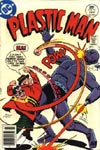 PLASTIC MAN #18
PLASTIC MAN #18
And pity poor Plas, just two issues to go in his short ‘70s run, that began at #11. Here he and his pal Woozy face off against, “Professor Klean the Mad Crusader,” by John Albano (writer), Romona Fradon (penciller), and Robert B. Smith (inker). After this, Plas, who had been around since Police Comics #1 (on-sale May 14, 1941) and was one of the last super-heroes to fade away after the Golden Age, would get his own Saturday morning tv show on ABC from Sept. 27, 1979 to Feb. 28, 1981. However, DC would not grant the stretchable sleuth his own mag again until allowing a four-issue mini-series in 1988. His next ongoing series, lasting just 20 issues, launched on Dec. 3, 2004. Still, for my money, the best DC version of the character was the Ty Templeton-created Plastic Man Special, issued June 2, 1999.
Thursday, March 17
G. I. COMBAT #202
Just the second dollar-sized issue (at a whopping 80 pages), gives us not one, not two, bur four stories of The Haunted Tank, two written by Robert Kanigher and two by Murray Boltinoff, with art chores by on three tales by Sam Glanzman and one by George Evans. Kanigher also provides story of O.S.S. Spies at War (with art by E.R. Cruz), and Woman at War (drawn by Fred Carrillo), along with a genre tale depicted by Romeo Tanghal, who was usually put to work as an inker, but was an able artists in his own right.
THE HOUSE OF SECRETS #146
Just eight issues away from cancellation at the hands of the infamous DC Implosion, this issue gives us two stories, “Snow Ghost,” by Bill Reilly (writer) and Bill Draut (artist), and, “Snake’s Alive,” by Michael Pellowski (plot), E. Nelson Bridwell (script), and Buddy Gernale (art).
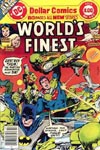 WORLD’S FINEST COMICS #245
WORLD’S FINEST COMICS #245
Also in its second outing as an 80-page Dollar Comics, this issue gives us the Superman/Batman team in the deja-vu inducing, “Today Mars, Tomorrow . . . the Universe,” by Bob Haney (writer), Curt Swan (penciller), and Murphy Anderson (inker); Green Arrow in, “The Man Bear Stalks at Midnight,” by Gerry Conway (writer), Michael Netzer (penciller), and Terry Austin (inker); Black Canary in “Hospital of Fear,” by the same team as the G.A. tale; the original cowboy Vigilante in, “The Plague Makers,” by Bill Kunkel (writer) and Gray Morrow (artist) — another series worth re-issuing in tpb form — and Wonder Woman of Earth-2 in, “Hell on Skis,” by Gerry Conway (writer), James Sherman (penciller) and BobWiacek (inker).
Tuesday, March 22
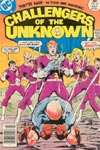 CHALLENGERS OF THE UNKNOWN #81
CHALLENGERS OF THE UNKNOWN #81
Seven years after their first series ended, and four years after a brief three-issue reprint run, the Challs are back in action to battle, “Multi-Man’s Master Plan,” with the help of Gerry Conway (writer), Michael Netzer (penciller), and Bob Wiacek (inker).
METAL MEN #52
Like the Challs, the Metal Men got canceled in the late ‘60s, revived via reprints in the early ‘70s, and returned in the late ‘70s for a short run of new adventures. This one is dubbed, ”Doctor Strangeglove and the Brain Children,” and it’s by Martin Pasko (writer) and Joe Staton (artist).
RAGMAN #5
It’s the final issue, which, given the slow return of sales figures back in the day, must have meant the first one sold absolutely abysmally. “Junkyard of Death” is by Robert Kanigher (writer) and Joe Kubert (artist), better known anyway for their war stories than super-heroics.
Thursday, March 24
THE SUPER FRIENDS #5
Junior Super Friends Wendy, Marvin, and Wonder Dog are still two issues away from being supplanted by the upstart Wonder Twins in, “Telethon Treachery,” by E. Nelson Bridwell (writer), Ramona Fradon (penciller), and Robert R. Smith (inker).
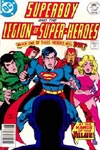 SUPERBOY #228
SUPERBOY #228
Although their name has graced the cover of this mag’ since #197, the Legion won’t get its name in the indicia as official series starts for another two issues. But first Chemical King buys the farm because, as he later admitted, writer Paul Levitz couldn’t figure out how to effectively use his power to speed up and slow down chemical reactions. “That a World Might Live, a Legionnaire Must Die,” is drawn by James Sherman (penciller) and Jack Abel (inker). It always seemed off to me that Levitz would kill of Condo (that’s his real name) just two week’s after having him be the hero of the hour in the DC Special issue covered above. Certainly, both stories were published closed enough together that Levitz must have known he planned to kill of the character when he elected to first give him one final star turn. Although I suppose it’s just as likely that immediately after writing the DC Special story, Levitz was, like, “Awww, man, screw this guy!”
THE UNKNOWN SOLDIER #206
Like Rock, the Soldier has recently made a long-running DC anthology his own, having taken over Star-Spangled War Stories with the previous issue. Here he faces a “Glory Gambit,” with Bob Haney (writer), Dick Ayers (penciller), and Gerry Talaoc (inker). Then, Fighting Devil Dog — not to be confused with Wild Dog — has to deal with an “Ambush Aftermath,” as depicted by Steve Skeates (writer) and Ric Estrada (inker) — not to be confused with Eric Estrada.
Tuesday, March 29
 DETECTIVE COMICS #470
DETECTIVE COMICS #470
While his JLA run languishes uncollected, Steve Englehart’s celebrated tenure on ‘Tec was compiled in the 1999 trade paperback Batman: Strange Apparitions. This second issue from that run features Part II of the debut of what was truly one of the scariest villains of my childhood. My nine-year-old self was seriously freaked out by the look of this baddie, and it’s too mad he’s appeared relatively rarely since. “The Master Plan of Dr. Phosphorus,” is drawn by Walt Simonson (pencils) and Al Milgrom (inks).
GREEN LANTERN #95
Co-starring Green Arrow, “Terminal for a Tragedy,” is by Dennis O’Neil (writer), Mike Grell (penciller), and Vince Colletta (inker) — or, that is to say, like most of the stuff from this era with his name on it, it’s inked by Vinny’s Ghost Patrol.
THE WARLORD #7
Reportedly one of DC’s top-selling series of the late ‘70s and early ‘80s, this issue features “The Iron Devil,” as written and drawn by character creator Mike Grell.
Thursday, March 31
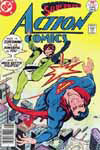 ACTION COMICS #472
ACTION COMICS #472
It’s the second appearance of Faora Hu-Ul, on whom Ursa of Superman movie fame would be based, in “The Phantom Touch of Death,” by Cary Bates (writer), Curt Swan (penciller), and Tex Blaisdell (inker). Then sportscaster Steve Lombard — the Reggie Mantle to Clark Kent’s Archie — gets a solo outing in, “If I’m Over Here . . . What Am I Doing Over There?” by Bill Kunkel (writer), John Calnan (penciller) and Blaisdell (inker).
SUPER-TEAM FAMILY #11
Another 48-page, 60¢ Giant, STF launches in this issue a four-part team-up epic starring The Atom — epic enough to be collected in 2007 as Countdown Special: The Atom #1-2. The Tiny Titan kicks things off here alongside Supergirl and The Flash in, “The Other Side of Doomsday,” with Gerry Conway (writer), Alan Weiss (penciller), and Josef Rubinstein (inker).
WONDER WOMAN #232
And finally, Wonder Woman is in the middle of a run aimed at mimicking her then current tv show by placing her adventures during World War II. In the DCU, that means Earth-2 and, naturally enough, a team-up with the Justice Society of America to save Steve Trevor, because he happens to be a dead-ringer for some long-dead Egyptian, in, “A Duel of Gods,” by Martin Pasko (writer), Michael Netzer (penciller), and Vince Colletta (inker).
So, there you have it, our spotlight week, plus the entire run-down of DC Comics from March 1977. The company issues 29 titles that month. These days, it puts out that many in a single week. But it was a light month. A lot of DC titles were on bi-monthly schedules at the time, and March was the skip month, as there were 31 titles released in both February and April.
The genre break-down for the month’s 29 titles looks like this:
Super-Hero — 18
War— 3
Ghost mystery — 2
Post-apocalypse — 2
Sci-fi — 2
Action/adventure — 1
Fantasy — 1
NEXT WEEK: The bubble goes back 20 years, one who generation, to the third week of March 1997, to witness the blue-hued horror, as Superman does the electric boogaloo!
Until, then, remember . . .
